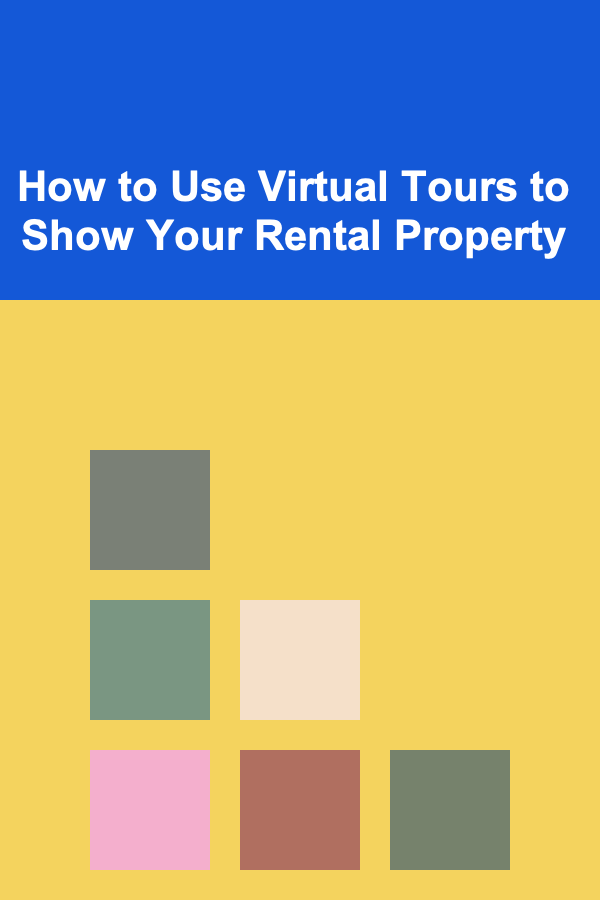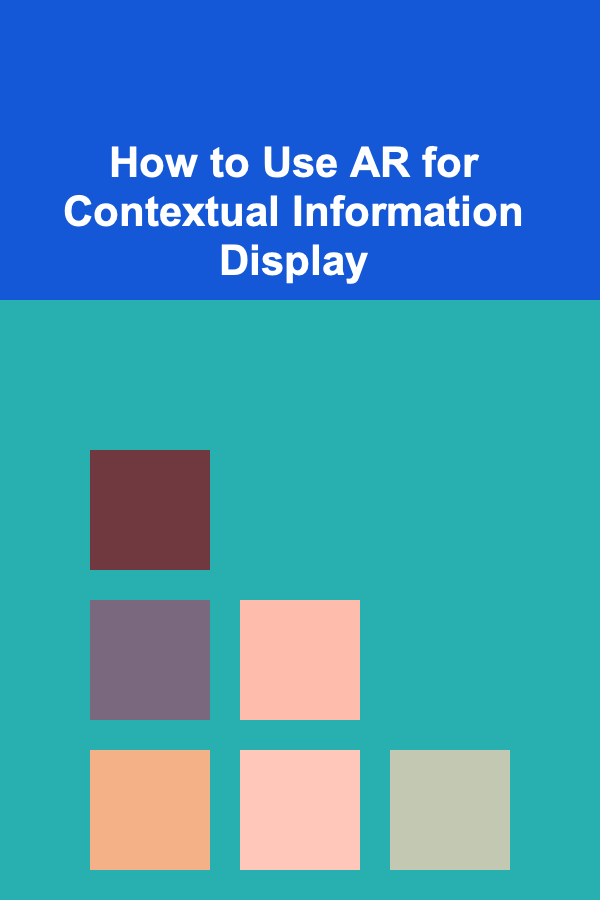
How to Use Virtual Tours to Show Your Rental Property
ebook include PDF & Audio bundle (Micro Guide)
$12.99$10.99
Limited Time Offer! Order within the next:

In the modern real estate landscape, technology has revolutionized how landlords and property managers showcase rental properties. One of the most significant developments is the use of virtual tours. Virtual tours are immersive, interactive tools that allow prospective tenants to explore a rental property remotely. These tours offer a host of benefits, from attracting a wider pool of tenants to streamlining the rental process. As virtual tours continue to gain popularity, it is essential for landlords to understand how to utilize this tool effectively to show their rental properties.
What is a Virtual Tour?
A virtual tour is a simulation of a physical space, typically made up of a series of photographs or videos that are stitched together to give viewers a 360-degree view. With a virtual tour, prospective tenants can move through rooms, view the space from different angles, and gain a sense of the layout and flow of the property, all from the comfort of their own home. Virtual tours can also be accompanied by additional features like floor plans, measurements, and detailed descriptions of the property's amenities.
There are two main types of virtual tours:
- 360-Degree Photos: These are interactive images that allow users to click and drag to change their viewpoint. This is typically less immersive than a video tour, but it still provides a comprehensive view of the property.
- Video Tours: These are more like traditional videos but with a cinematic feel. Some video tours are filmed in a way that mimics walking through the space, providing a more natural experience, while others may include narration or on-screen text.
While both types can be effective, the goal of a virtual tour is always to provide potential renters with as much information as possible about the property, its layout, and its features, without them needing to physically visit the site.
Why Should You Use Virtual Tours for Rental Properties?
1. Increased Reach
One of the most significant advantages of virtual tours is their ability to expand your reach. With traditional in-person showings, you are limited to the geographical location of your property and the availability of potential tenants. However, virtual tours allow individuals from anywhere in the world to view your property, regardless of distance. This is particularly beneficial for attracting tenants relocating from out of town, international students, or those with busy schedules.
2. Convenience for Tenants
Virtual tours are incredibly convenient for prospective tenants. They allow individuals to explore properties at their own pace, at any time of day or night, without the need to schedule a physical visit. This convenience can lead to more inquiries and increase the likelihood of finding a tenant faster.
3. Reduced Showings
Conducting in-person showings can be time-consuming, especially if you have multiple properties or tenants who aren't serious about renting. Virtual tours help filter out uninterested or unqualified applicants, as potential tenants can view the property in detail before committing to a visit. This reduces the number of unnecessary showings, saving time for both landlords and tenants.
4. Showcasing the Property 24/7
With virtual tours, your rental property is available for viewing 24/7, even outside of regular business hours. This is particularly beneficial for tenants who may be working during the day or those in different time zones. Having an always-accessible virtual tour can be a game-changer when it comes to attracting tenants.
5. A Competitive Edge
In a competitive rental market, properties with virtual tours stand out. Offering a virtual tour demonstrates that you are using modern technology to make the rental process easier and more efficient. This can give your property an edge over others that don't offer virtual tours, especially when potential tenants are looking for convenience and accessibility.
6. Reduces the Risk of No-Shows
In-person showings often come with the risk of no-shows, which can be frustrating and waste valuable time. Virtual tours reduce the likelihood of no-shows since prospective tenants can view the property without making a firm commitment to a physical showing. If they are interested, they can move forward with an in-person visit or application.
How to Create a Virtual Tour for Your Rental Property
Creating a virtual tour for your rental property may seem like a daunting task, but it's easier than you think. There are several methods you can use to create a high-quality virtual tour, depending on your budget, technical ability, and desired level of interactivity.
1. DIY with 360-Degree Cameras
For landlords looking to create their own virtual tours, investing in a 360-degree camera can be an excellent option. These cameras are affordable and easy to use, providing high-quality images that can be stitched together to create an immersive virtual tour. Many cameras, such as the Ricoh Theta or Insta360, allow you to take panoramic photos or videos, which can then be uploaded to a virtual tour platform for viewing.
Steps to Create a DIY Virtual Tour:
- Step 1: Purchase or rent a 360-degree camera. Ensure you have a tripod and any necessary accessories.
- Step 2: Plan your route and the key areas you want to showcase in the tour, such as the living room, kitchen, bedrooms, bathrooms, and any special features.
- Step 3: Set up the camera in each room, making sure it's positioned to capture the entire space. It's best to shoot in high resolution for the best experience.
- Step 4: Use the camera's software or a third-party platform to stitch the photos or videos together into a cohesive tour.
- Step 5 : Upload the tour to a virtual tour hosting platform, such as Matterport , Google Street View , or Kuula. Many of these platforms offer free or affordable hosting plans, depending on the complexity of your tour.
- Step 6: Share the virtual tour link on your property listings, website, and social media to attract potential tenants.
2. Hire a Professional Service
For those looking to save time and ensure a higher level of quality, hiring a professional photographer or virtual tour provider may be the best option. Many real estate photographers now offer virtual tour services, and they have the expertise and equipment to create polished, high-quality tours.
Professional virtual tour providers typically offer additional services, such as:
- Interactive Features: These may include clickable hotspots that provide more information about specific areas of the property.
- Floor Plans: Some services can create 3D floor plans that offer a more detailed understanding of the property's layout.
- Enhanced Visuals: High-end equipment and post-production editing can create a more visually appealing and engaging virtual tour.
While hiring a professional service comes at a cost, the result is often a higher-quality product that may attract more tenants and justify the investment.
3. Use Video Tours
If you're not interested in 360-degree photos, another option is to create a traditional video tour. This can be done with a smartphone or camera, and it involves filming yourself or someone else walking through the property, explaining key features, and showcasing different rooms.
A video tour can provide a more personal touch, as you can speak directly to the viewers and highlight what makes your property special. You can also use narration or add text overlays to provide additional context, such as rental terms or nearby amenities.
Steps to Create a Video Tour:
- Step 1: Plan your video tour route and script any commentary you'd like to include. Be sure to highlight key selling points, such as updated appliances, spacious rooms, or outdoor areas.
- Step 2: Set up your camera or smartphone on a tripod to ensure smooth footage. Use a gimbal or stabilizer if available.
- Step 3: Walk through the property, filming each room and providing commentary on its features. Be sure to capture the overall flow of the property.
- Step 4: Edit the video, trimming any unnecessary parts, adding text or graphics, and adjusting the lighting or color as needed.
- Step 5: Upload the video to platforms like YouTube, Vimeo, or your property listing site.
- Step 6: Share the video link on your listings and social media channels to attract potential tenants.
4. Use Real Estate Platforms with Built-in Virtual Tours
Several real estate listing platforms now allow landlords to upload virtual tours directly to their property pages. These platforms provide an easy way to showcase your property to potential tenants without needing to deal with third-party hosting.
Some of the most popular platforms include:
- Zillow: Zillow allows landlords to upload virtual tours and 3D home tours directly to their listings, making it easy for tenants to access the content.
- Apartment Finder: This platform offers interactive floor plans and virtual tour options for property managers.
- Rent.com : Rent.com also offers a virtual tour feature for landlords to upload and showcase their properties.
Using these platforms can simplify the process and increase the visibility of your rental property.
Best Practices for Virtual Tours
1. Keep the Property Clean and Well-Prepared
Just as you would prepare for an in-person showing, make sure the property is clean, well-lit, and staged for the virtual tour. Pay attention to small details like tidying up rooms, adjusting lighting, and ensuring everything is in its place. A well-presented property will make a lasting impression.
2. Highlight the Key Features
Make sure to highlight the most attractive aspects of the property. Whether it's a newly renovated kitchen, a spacious backyard, or the proximity to local amenities, make sure these features are prominently showcased in your virtual tour.
3. Provide Clear and Concise Information
Include as much relevant information as possible within the tour, such as rent prices, availability dates, and property policies. If you have additional amenities (like parking or storage), make sure these are clearly visible in the virtual tour.
4. Optimize for Mobile Viewing
Many prospective tenants will be viewing your virtual tour on a mobile device, so ensure that the tour is mobile-friendly. Test the experience on various devices to ensure it works seamlessly and the quality is high.
Conclusion
Virtual tours are a game-changer for landlords looking to streamline the rental process and attract tenants quickly. By providing a convenient and immersive way for potential renters to view your property, you can increase engagement, reduce vacancy times, and improve tenant satisfaction. Whether you choose to create a DIY tour with a 360-degree camera, hire a professional, or use a video tour, the key to success is offering an informative and visually appealing experience. Embrace the power of virtual tours, and watch as they transform the way you show your rental property.

How to Master Video Workflow Management
Read More
How To Practice Yoga for Stress Relief
Read More
How to Regularly Check and Maintain Your Home's Attic Insulation
Read More
How to Store Cables and Tech Accessories Neatly
Read More
How to Use AR for Contextual Information Display
Read More
How to Interpret Astrological Charts for Beginners
Read MoreOther Products

How to Master Video Workflow Management
Read More
How To Practice Yoga for Stress Relief
Read More
How to Regularly Check and Maintain Your Home's Attic Insulation
Read More
How to Store Cables and Tech Accessories Neatly
Read More
How to Use AR for Contextual Information Display
Read More